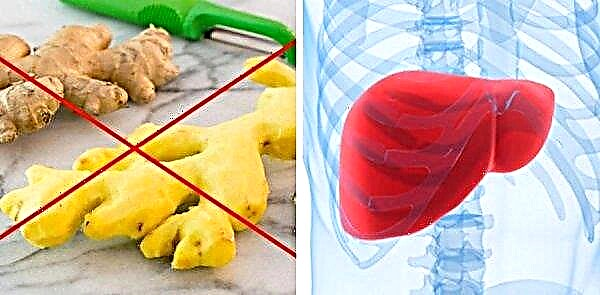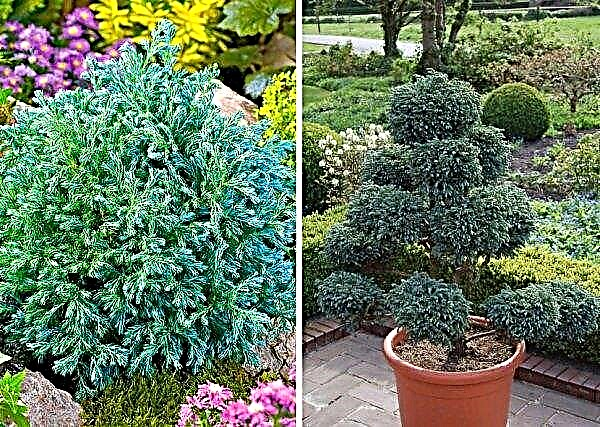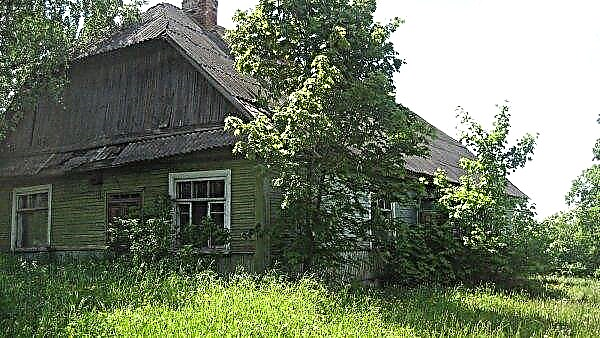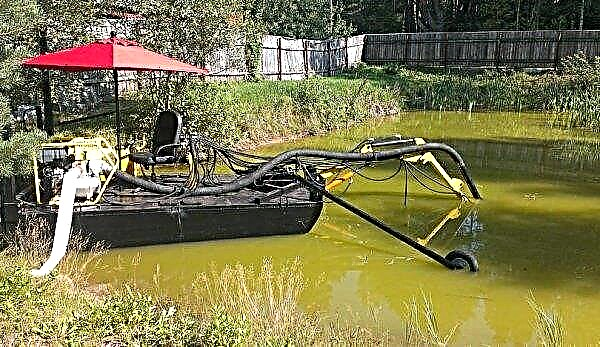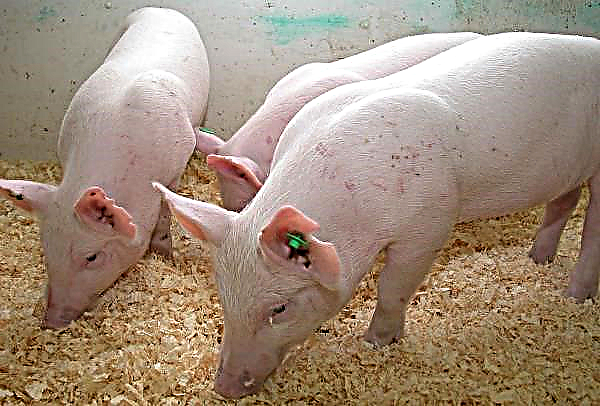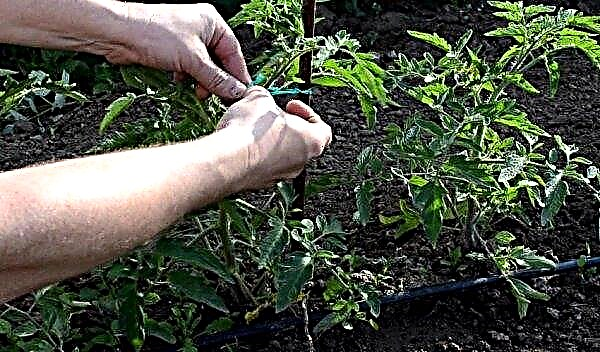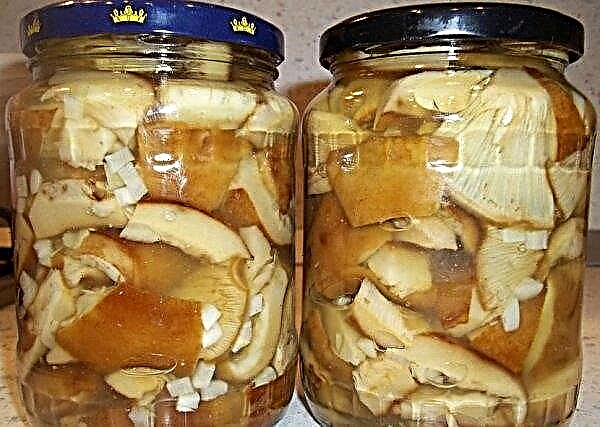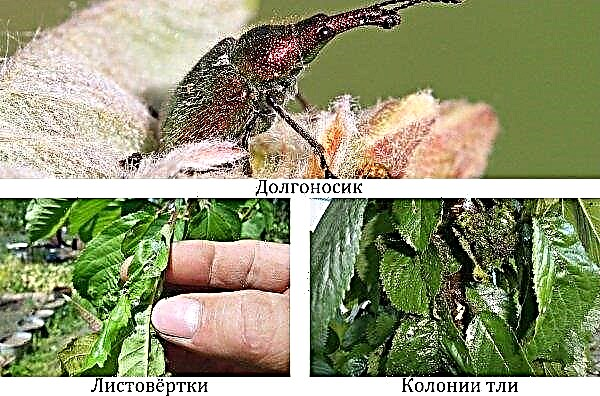Many people dream of having a real palm tree in a large wooden tub at home, but it is not always possible to find the necessary amount of space for this tall and sprawling tree. Fortunately, there are special types of palm trees, as if specially designed for indoor cultivation. They do not take up much space, but are very decorative. A striking example of such palm trees in miniature is rape. We will tell you more about it.
Botanical description of the plant
The concept of "rapis" (Rhapis) combines the genus of low bushy bamboo palm trees, which includes about 10 different species. The homeland of these plants, also called Lady Palms, is the southeastern territories of Asia, partially capturing China, Japan and the Malay Archipelago. However, almost 2.5 centuries ago, these palm trees were brought to Europe and took root well there, and mainly as indoor plants.
| Maximum sizes | From 1.5 to 3 m - depending on the type |
| Root system | Powerful, horizontal type, deep from the surface of the earth does not go away |
| Stem | Reed (bamboo) type, thin (diameter about 3-4 cm), densely covered with fibers |
| Leaf shape | Fan-shaped, consisting of 7–10 finger-shaped segments. The width of each such segment at the base can be up to 5 cm, the length up to 30 cm. The dissection of the leaves is very deep, not less than 2/3, and sometimes almost to the very base. The short petiole has the same fleecy coating as the stems. Small leaf sizes |
| Leaf color | Dark green with a beautiful sheen |
| Leaf structure | Hard |
| Inflorescence | Branched, axillary type, collected in a brush |
| Flower shape | Calyx with 3 cloves, with club-shaped (in male flowers) or ovoid (in female flowers) corolla and 6 stamens |
| Flower type | Bisexual and same-sex |
| Flower color | Ivory |
| Fruit type | Spherical fleshy berry |
| Fruit color | White |
| The taste of fruit | The fruits are inedible |
Important! Young rape forms leaves, on which only two segments are first formed, which greatly upset inexperienced gardeners who believe that they mistakenly acquired some other plant. In fact, this is the age-related feature of the bamboo palm: as it grows, its leaves acquire the desired fan shape.
Main types
Among the most famous species of Lady Palms, which today are distributed far beyond the borders of their homeland, the following should be mentioned:
- Rhapis humilis (low rapis). This palm tree comes from China. It has compact dimensions, does not grow above a meter and a half in height, and until recently it was the only variety of Lady Palms that could be purchased at flower shops. In appearance, the plant resembles a lush spherical bush, consisting of a large number of decorative fan-shaped leaves. There are specially bred varieties of Rhapis humilis, the leaves of which are variegated. Such palm trees are especially popular and are often used to decorate modern offices and urban apartments with designer renovations.

- Rhapis excelsa, aka Rhapis flabelliformis (high rapeseed, or fan-leafed). This variety is of Japanese origin. It looks good in more spacious rooms, for this reason it is not suitable for everyone. However, in the hotel halls or large private houses, such a spectacular plant looks unique. In contrast to Rhapis humilis, tall and thin Rhapis excelsa can be clearly seen in long and thin bamboo-like stems, but they end with spreading leaves characteristic of this palm tree species, divided into finger-shaped segments. In height, the tree can grow up to 3 m. There are specimens with variegated leaves.
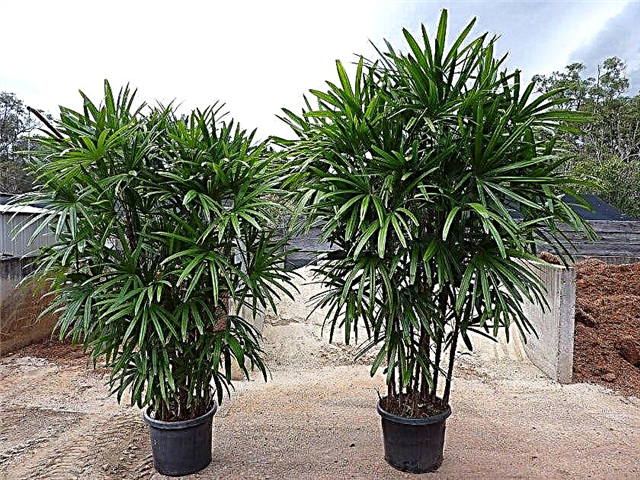
- Rhapis multifida (raspis multifractured). Externally, this variety of bamboo palm almost does not differ from Rhapis humilis. However, its main feature is that the number of segments in a leaf plate in Rhapis multifida is not the usual 7-10 pieces, but much more - in adult plants such fingers can be from one and a half to three and a half dozen on each leaf. Rhapis multifida is a rather rare variety of Lady Palms, although, according to many gardeners, this plant is the most spectacular.
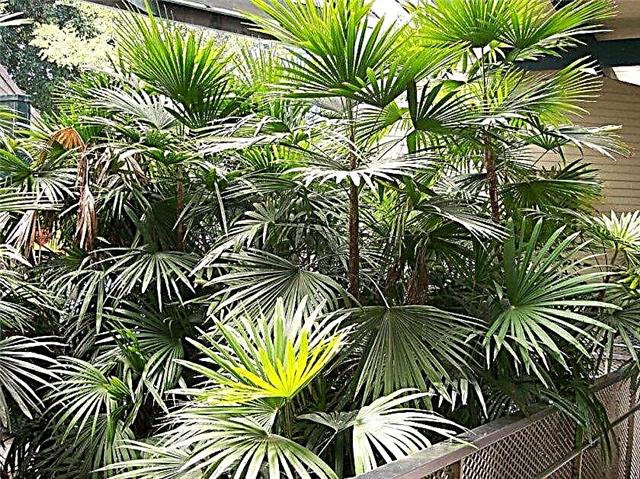
- Rhapis subtilis (rapis thin). This species of bamboo palm tree native to Thailand, Laos, Cambodia and the island of Sumatra is even less known than its multi-dissected "relative." It reaches a height of 3 m. The main distinguishing feature of the species is not so much its external characteristics as habitual conditions. If the bamboo palm trees listed above grow in the subtropics, then Rhapis subtilis is a truly tropical plant. It does not tolerate cold air, it is rather demanding on humidity, therefore it is grown less often at home.
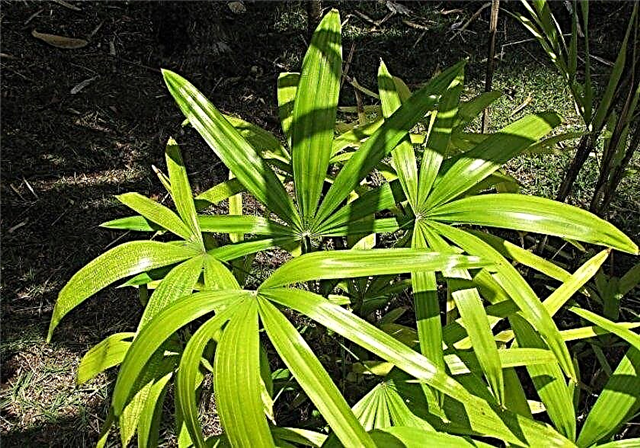
House growing conditions
Often, the temptation to buy a palm tree as a house flower is kept by the fact that at home it will not be possible to create favorable conditions for this inhabitant of the tropics, in particular, to provide sufficient light and an appropriate level of humidity.
Such fears are partly true, but of all the types of palm trees, raspis, perhaps, is one of the most unpretentious. That is why he is so loved by gardeners.
Lighting
All palm trees, like any other tropical plants, need an abundance of light. Even direct midday rays for these trees are less dangerous than a dull shadow. However, under indoor conditions, it is still recommended to place the flowerpot near windows facing the east or west side, and on the southern windows in the summer, slightly shade to keep the light scattered.
 Indoor palm trees have the ability to adapt to the proposed lighting conditions and adapt to new ones very hard, so the flowerpot should not be moved from one place to another, but the newly acquired flower must first be shaded and then lighting added gradually.
Indoor palm trees have the ability to adapt to the proposed lighting conditions and adapt to new ones very hard, so the flowerpot should not be moved from one place to another, but the newly acquired flower must first be shaded and then lighting added gradually.
Important! For variegated varieties of bamboo palm trees, having good lighting is especially important. If such plants do not receive a sufficient amount of sunlight, their leaves lose their decorativeness and become monophonic.
But at the same time, in order for the plant to develop evenly and form a beautiful crown from all sides, it must be periodically rotated around its axis so that all leaves receive the same amount of light.
Ventilation
If it is possible to take a flowerpot with a bamboo palm to the open air (to a balcony or to a summer residence) in the summer, this must be done. A constant stay indoors slows down the development of an unpretentious flower, but a light breeze will strengthen its immunity and protect it from diseases for a long time.  If the plant is kept in the office, the window near which it grows needs to be opened more often in warm times, providing the leaves with fresh air. Nevertheless, ventilation should be distinguished from draft, its effect is harmful to flowers as well as to people.
If the plant is kept in the office, the window near which it grows needs to be opened more often in warm times, providing the leaves with fresh air. Nevertheless, ventilation should be distinguished from draft, its effect is harmful to flowers as well as to people.
Temperature mode
Rapis develops well at ordinary room temperature. Only temperature differences are undesirable because of the air conditioners switched on in summer, and the +18 ºC favorite mode for many office workers for a palm tree is still very cool. The optimal conditions for the plant are the range between +20 and +22 ºC, and it can be adhered to both in winter and in summer.
Did you know? The world's tallest palm is Ceroxylon quindiuense, or a wax Kindio palm. This wonderful tree is growing in Colombia, reaching over fifty meters in height for more than a hundred years of its life, while having a trunk diameter of only half a meter at the base.
In the cold season, many indoor flowers need a dormant period, accompanied by a decrease in temperature and a decrease in irrigation intensity, however, this condition is not necessary for a decorative-deciduous and practically non-blooming palm house. If the flower is not contained in the living room, the resting phase will not harm it, however, in this case it is advisable to ensure that the temperature does not fall below +16 ºC (+10 ºC for a thermophilic plant is a critically low indicator).
Air humidity
Contrary to frequently expressed fears, bamboo palm trees do not feel the need for high humidity. The parameters normal for a living space of 60–65% are quite acceptable for this plant. Nevertheless, rapis will respond to a refreshing shower and regular spraying of leaves with great gratitude, it is especially important to carry out such procedures in rooms where the air is warm and dry, and ventilation is not carried out (during the heating period these conditions are present in many city apartments and offices) .

How to care at home
Caring for Lady Palms is easy. You only need to know the basic requirements for watering and fertilizing, transplant the plant on time and make sure that it does not hurt and is not exposed to pest attacks.
Watering
All palm trees need plentiful watering. Frequent, but limited in volume of application of fluid to the soil leads to drying out of the roots, so during irrigation it is very important to ensure that not only the top soil layer, but also the entire earthen lump is moistened to the bottom. A vivid evidence of this is the appearance of water in the pan, which, however, does not need to be left in it: it should be carefully drained.
You need to water the rape seed with soft and warm water up to +20 ... + 23 ° С. It is better not to use tap water for such purposes, but if there is no choice, it must first be defended in an open container for at least a day.
In winter, irrespective of whether the plant is introduced into the dormant phase, watering is usually reduced, because due to a lack of lighting and lowering air temperature, the moisture demand of the flower is greatly reduced.
Along with root watering, it is also useful to use surface water by spraying warm water from a spray bottle onto the green parts of a palm tree. The latter method should not be used if the room temperature drops below +18 ° C.
Top dressing
In order for rape to develop successfully, it needs to be fed regularly. This procedure should be carried out only during the period of active vegetation (it begins at the end of February with an increase in the length of daylight and ends around mid-autumn). The frequency of the procedure depends on the condition of the flower and the time that has passed since it was transplanted into a new fertile substrate, but on average fertilizers are applied about twice a month.

In specialized stores you can find a wide range of complex fertilizers for palm trees, for example, among the most popular brands include:
- Activin;
- “Mr. color. Palm";
- Bon Forte;
- "Florovit";
- "Growth" (Palm);
- "Success";
- crystalline fertilizer "For palms" TM Royal Mix;
- "Standart NPK for palm trees" and many others.
Before applying the nutrient solution to the soil, it must be abundantly watered, otherwise the concentrated mineral mixture may burn the roots. After transplantation and during the illness, indoor plants do not fertilize.
Pruning
Bamboo palm trees do not need to form or rejuvenate pruning, but at the beginning of the growing season, in order to increase the decorativeness of the plant and give it new strength for growth, carefully remove all dried, yellowed and wilted leaves.
In order to avoid infection of the aerial part of the flower with a fungal or bacterial infection that can get into an open wound, including with water, the rape seed should not be sprayed after pruning for at least a week.
Transfer
Unlike many other indoor plants that need to be replanted annually, rape seedy does not tolerate such a procedure, and therefore it should not be carried out too often. Updating the soil mixture in the pot is enough to pour a fresh layer directly on top of the old one. In the process of palm growth, its root system fills the entire pot with itself and, if you do not provide the plant with additional area for development, it will begin to hurt and may even die. It is easy to determine the critical moment: if, having picked up a flower, you see fragments of roots sticking out of the drainage holes of the pot, it means that the palm is already cramped in its former capacity.
In the process of palm growth, its root system fills the entire pot with itself and, if you do not provide the plant with additional area for development, it will begin to hurt and may even die. It is easy to determine the critical moment: if, having picked up a flower, you see fragments of roots sticking out of the drainage holes of the pot, it means that the palm is already cramped in its former capacity.
Since moving to a new place for a rape that is sensitive to changes in external conditions is a serious stress, it is better to postpone the transplant for about two weeks. In other cases, the procedure is best carried out at the end of winter or the beginning of spring, at the start of a new vegetation cycle.
Palm trees, especially adults, need to be transplanted exclusively by transshipment, trying not to disturb the root system and not destroy the earthen lump.Important! Regardless of the size of the pot, indoor plants purchased in flower shops should always be transplanted to new land. This is explained by the fact that manufacturers use special transportation substrates for sale, which contain an increased amount of vitamins, but are completely unsuitable for flowers as permanent soil.
The roots of the rape are located close to the surface of the earth and grow horizontally rather than vertically, so it is best to choose a wide and not very deep pot. Despite the painful attitude of the plant to the transplant, you should not take a flowerpot much larger than the previous one. To make it easier to root a flower, leaning on the walls of the pot, it is best to give preference to a container whose diameter is only 2-3 cm larger than the size of the former.
First, drainage is introduced into the prepared pot. Expanded clay is traditionally used in this capacity, but instead of it you can take small pebbles, screenings, crushed stone or coarse sand. The thickness of the drainage layer must be at least ¼ of the volume of the pot. Then a small amount of soil mixture is poured into the tank. It is best for this purpose to purchase special substrates for palm trees, although you can prepare the soil yourself. To do this, turf ground, rotted compost and peat are mixed in equal proportions, after which a little river sand, hydrogel or marsh moss is added to the resulting mixture to increase its lightness.
Then a small amount of soil mixture is poured into the tank. It is best for this purpose to purchase special substrates for palm trees, although you can prepare the soil yourself. To do this, turf ground, rotted compost and peat are mixed in equal proportions, after which a little river sand, hydrogel or marsh moss is added to the resulting mixture to increase its lightness.
After the pot is prepared, the palm must be very carefully removed from the previous container, put in a new one and quickly compacted with fresh soil mixture from all sides. So much earth is added to the surface of the pot so that at least 2 cm remains to the edge, otherwise the plant will be difficult to water. After filling the pot, the substrate must be well tamped and, if necessary, add an additional layer of earth.
It is advisable to protect the newly transplanted palm during the first three weeks from direct sunlight, not to fertilize, but to regularly water and ventilate.
Breeding
There are three main ways to reproduce bamboo palm trees:
- root offspring;
- division of the maternal rhizome;
- seeds.
 If the root, which was able to be separated along with the handle, turned out to be too small, the shoot can be placed for some time in water with the addition of a rooting stimulating preparation. As for the two other methods of propagation of the rape, we need to talk about them in more detail.
If the root, which was able to be separated along with the handle, turned out to be too small, the shoot can be placed for some time in water with the addition of a rooting stimulating preparation. As for the two other methods of propagation of the rape, we need to talk about them in more detail.
Rhizome division
During the transplantation of a well-clotting bamboo palm tree instead of a larger pot, you can simply divide the plant into several parts, each of which can be planted in a separate flowerpot. In this case, it is advisable not to completely destroy the earth lump, and not to expose the roots.
With a sharp knife, starting from the surface of the earth, the bush is cut in height into 2 or 3 parts so that each fragment has an equal number of shoots and rhizomes. Then, with each part, the usual transplant procedure is performed according to the scheme described in detail above. Quarantine for such a plant must be provided for longer, because damage to the root system is always a serious stress for the palm.
Then, with each part, the usual transplant procedure is performed according to the scheme described in detail above. Quarantine for such a plant must be provided for longer, because damage to the root system is always a serious stress for the palm.
Seeds
Growing a palm from seeds is a long-term business, but it’s fascinating.
Important! Seeds of bamboo palm need to be planted immediately after collection or acquisition, since their germination is inversely proportional to the shelf life.
Before planting, the seed material is soaked for 5 days in a growth stimulator (you can use Kornevin, Zircon, Epin, Fumaru and other similar preparations). Then, each seed should be very carefully punctured with a needle to destroy a dense capsule, but not damage the embryo.
In the prepared container (you can use a box, a box, a cassette for seedlings or ordinary plastic cups) with previously made drainage holes in it to drain excess water, pour the soil mixture and water it abundantly. When the water drains and evaporates a little, the seeds are slightly pressed into the soil with an incision down. It is not necessary to fill them with earth from above, it will stretch the already long process of germination.
After planting, the container is tightened with a film or covered with glass and placed for germination in a slightly darkened place at a temperature of + 22 ... + 27 ºC. Before emergence (this process can stretch for two, and sometimes three months), the greenhouse should be regularly ventilated, removing the film or glass for a while. After the germination of the palm cover is removed.
Rape planting in separate pots can be carried out when young seedlings reach a growth of 4 cm.
Growing difficulties
When growing a bamboo palm, you can encounter such difficulties:
- Drying and yellowing of leaves, starting at the tips. This usually happens if the air in the room is too dry and not ventilated. The problem is solved by regular spraying of the plant with warm water.
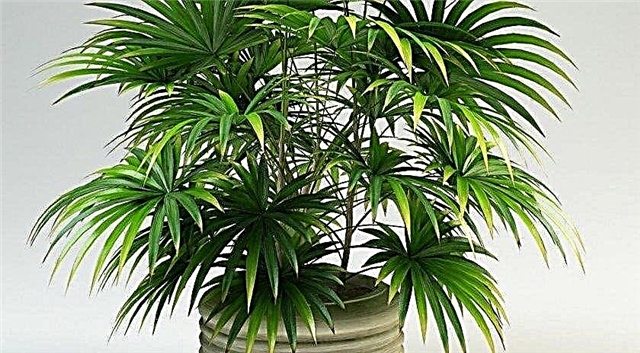
- The appearance of yellow spots on a leaf plate. It usually indicates a sunburn. The flower must be protected from direct rays, and the affected leaves should be carefully cut.
- Brown spots on the leaves. They occur at elevated temperatures, combined with dry air. It is treated by ventilation, spraying and placing the pot in a cooler place.
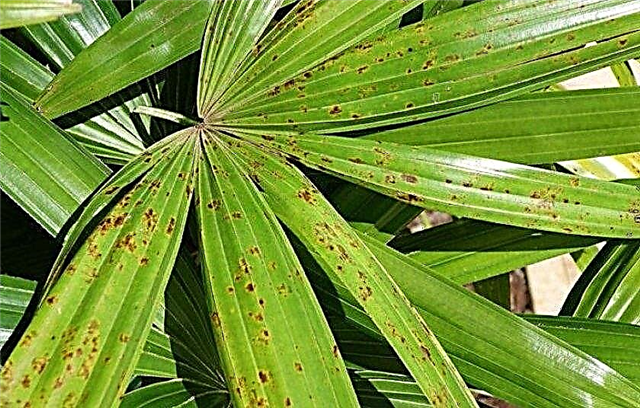
- Withered leaves. They signal the drying out of the soil (or its lower layer) and the need for abundant watering.
- The combination of darkening and wilting leaves - A sure sign that the palm is freezing. The flower must be transferred to a warm room.
- Stunted growth. Two reasons are possible - depleted soil (lack of fertilizer) or a too small pot (transplant is required).
- Premature leaf opening. Such a specific symptom in palm trees occurs in case of damage to the root system. Sometimes it is enough just to reduce watering, but if the problem is not solved, the plant needs to be replanted with simultaneous disinfection of the roots.
Of the pests for rape the most dangerous are:
- scale shield - characterized by the appearance of brown plaques on a leaf plate;
- spider mite - easily identified by specific threads stretched between the leaves and their segments;
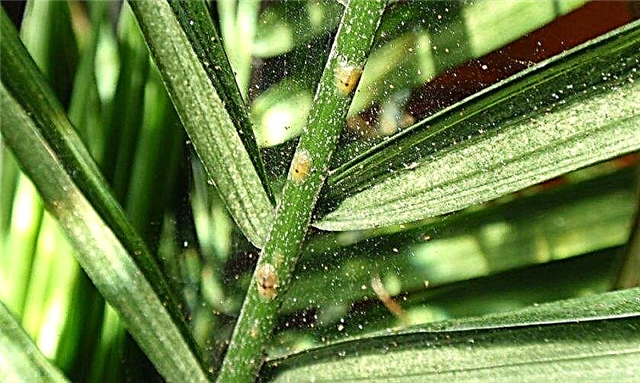 Scaffold and spider mite
Scaffold and spider mite - feltman - manifests itself in the presence of white lumps similar to cotton, accumulating at the base of the leaf.

Parasites visible to the naked eye must be removed with a toothpick or cotton pad moistened with alcohol. An effective folk remedy to combat any of the pests mentioned is to treat the green parts of the palm with a soap solution, in which crushed garlic or onions can be added.
Did you know? The most poisonous plant in the world has a completely peaceful and even divine name - the palm of Christ. This perennial is also known as ricin, castor oil or castor oil. Deadly poison is found in the seeds of a plant that is not really a palm tree.
If such measures do not give results, it is necessary to use insecticides (remedies against insect parasites), acaricides (remedies against ticks) or universal pesticides designed to combat both of these categories of pests. Examples of the latter include drugs such as Fitoverm, Vermitek, Aktofit, Actellik, Akarin, Apollo and others.
Signs and superstitions
With indoor plants associated with many signs and superstitions. It is believed that some flowers carry a positive burden and promise happiness and prosperity, while others, on the contrary, are better not to take into the house, since they attract evil forces, take energy and can even cause serious illness and death of some of the household.

And here's what is interesting: both positive and negative supernatural properties can be attributed to the same flower. One example is the palm tree. There are many superstitions that say that this tree can never be kept in the house, and about the same number will take a directly opposite direction.
Those who like to pay attention to all sorts of superstitions should take into account such advice of esotericists:
- you can not keep a palm tree in a tight tub, since the negative energy released by the suffering plant will be transmitted to households;
- the mystical power of the tree will have a positive orientation, if you place the pot in the southeast corner of the room, where there is a lot of light and free space;
- Palm tree is good for decorating the living room, corridor or hallway, study, hall, dining room, but in the bedroom and, especially, the children's room, the energy of this flower shows its negative side.
The more kindness, laughter and positive emotions present in the room where the tub with the tree is standing, the more comfortable the people in the house will feel. And vice versa. The reason is simple: everything that the palm tree incorporates is then thrown back into the external environment.Did you know? There is a belief that if rapis appears in the house of a childless family, the cherished replenishment awaits the couple in the near future.
If the leaves of the plant look healthy, dense and bright green, it means that good powers rule the house. Dark stems and leaves indicate that the tree is fighting the evil that has penetrated the house.
Many eastern religions associate the palm with the energy of the sun, which accumulates in the trunk of a tree. From here comes the belief that it is good to decorate rooms in which people practice yoga, Chinese qigong wellness exercises, Pilates and other types of physical exercises that are not quite traditional for Europeans.
Rapis is a versatile indoor palm that fits equally well in the interior of a small city apartment, as well as in the spacious hall of a country house, a prestigious office and even a fashionable hotel or restaurant. With high decorative qualities, this plant is very unpretentious and does not require special care, so it is great for beginner gardeners or people who are not ready to spend a lot of time on pruning, transplanting and other manipulations with indoor flowers.







 Scaffold and spider mite
Scaffold and spider mite
